Critical Appraisal Report: Drug Testing Service at Music Festivals
VerifiedAdded on 2022/11/13
|8
|1915
|325
Report
AI Summary
This report offers a comprehensive critical appraisal of the research article titled "Music festival attendees’ illicit drug use, knowledge and practices regarding drug content and purity: a cross-sectional survey." The report begins by evaluating the authors' expertise and potential conflicts of interest, followed by an examination of the research question, design, and methodology. Strengths such as the use of survey analysis and statistical methods are highlighted, alongside limitations including participant demographics and potential biases. The study's findings, which suggest that drug checking services do not necessarily encourage drug use but rather provide information, are then applied to a case scenario involving a mother's concerns about her daughter attending a music festival with drug checking services. The report considers enablers and barriers to the research findings' uptake, such as the relevance of the study to the scenario and the potential for sampling bias. The conclusion emphasizes the need for further research to fully understand the impact of drug checking services, particularly in the context of music festivals and young populations.
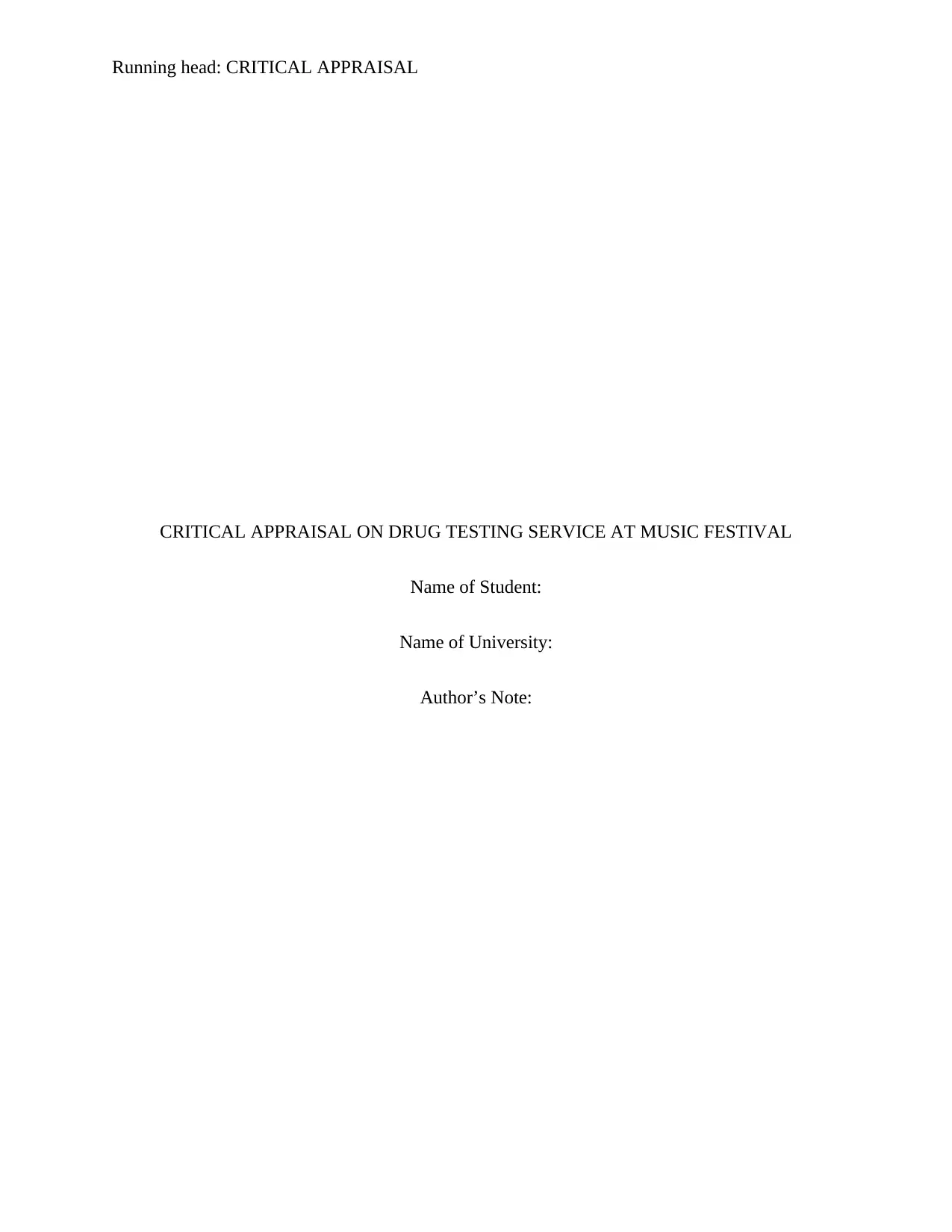
Running head: CRITICAL APPRAISAL
CRITICAL APPRAISAL ON DRUG TESTING SERVICE AT MUSIC FESTIVAL
Name of Student:
Name of University:
Author’s Note:
CRITICAL APPRAISAL ON DRUG TESTING SERVICE AT MUSIC FESTIVAL
Name of Student:
Name of University:
Author’s Note:
Paraphrase This Document
Need a fresh take? Get an instant paraphrase of this document with our AI Paraphraser
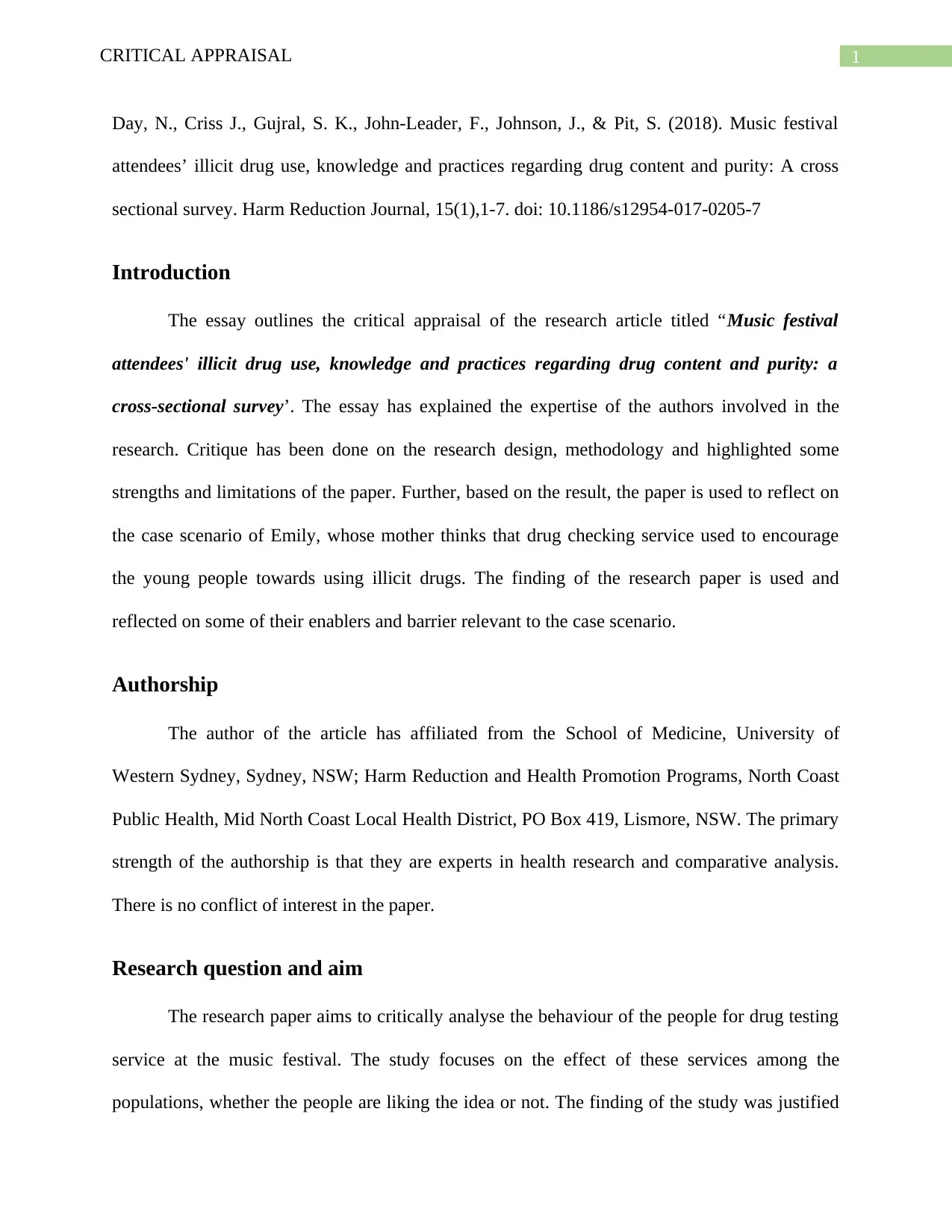
1CRITICAL APPRAISAL
Day, N., Criss J., Gujral, S. K., John-Leader, F., Johnson, J., & Pit, S. (2018). Music festival
attendees’ illicit drug use, knowledge and practices regarding drug content and purity: A cross
sectional survey. Harm Reduction Journal, 15(1),1-7. doi: 10.1186/s12954-017-0205-7
Introduction
The essay outlines the critical appraisal of the research article titled “Music festival
attendees' illicit drug use, knowledge and practices regarding drug content and purity: a
cross-sectional survey’. The essay has explained the expertise of the authors involved in the
research. Critique has been done on the research design, methodology and highlighted some
strengths and limitations of the paper. Further, based on the result, the paper is used to reflect on
the case scenario of Emily, whose mother thinks that drug checking service used to encourage
the young people towards using illicit drugs. The finding of the research paper is used and
reflected on some of their enablers and barrier relevant to the case scenario.
Authorship
The author of the article has affiliated from the School of Medicine, University of
Western Sydney, Sydney, NSW; Harm Reduction and Health Promotion Programs, North Coast
Public Health, Mid North Coast Local Health District, PO Box 419, Lismore, NSW. The primary
strength of the authorship is that they are experts in health research and comparative analysis.
There is no conflict of interest in the paper.
Research question and aim
The research paper aims to critically analyse the behaviour of the people for drug testing
service at the music festival. The study focuses on the effect of these services among the
populations, whether the people are liking the idea or not. The finding of the study was justified
Day, N., Criss J., Gujral, S. K., John-Leader, F., Johnson, J., & Pit, S. (2018). Music festival
attendees’ illicit drug use, knowledge and practices regarding drug content and purity: A cross
sectional survey. Harm Reduction Journal, 15(1),1-7. doi: 10.1186/s12954-017-0205-7
Introduction
The essay outlines the critical appraisal of the research article titled “Music festival
attendees' illicit drug use, knowledge and practices regarding drug content and purity: a
cross-sectional survey’. The essay has explained the expertise of the authors involved in the
research. Critique has been done on the research design, methodology and highlighted some
strengths and limitations of the paper. Further, based on the result, the paper is used to reflect on
the case scenario of Emily, whose mother thinks that drug checking service used to encourage
the young people towards using illicit drugs. The finding of the research paper is used and
reflected on some of their enablers and barrier relevant to the case scenario.
Authorship
The author of the article has affiliated from the School of Medicine, University of
Western Sydney, Sydney, NSW; Harm Reduction and Health Promotion Programs, North Coast
Public Health, Mid North Coast Local Health District, PO Box 419, Lismore, NSW. The primary
strength of the authorship is that they are experts in health research and comparative analysis.
There is no conflict of interest in the paper.
Research question and aim
The research paper aims to critically analyse the behaviour of the people for drug testing
service at the music festival. The study focuses on the effect of these services among the
populations, whether the people are liking the idea or not. The finding of the study was justified
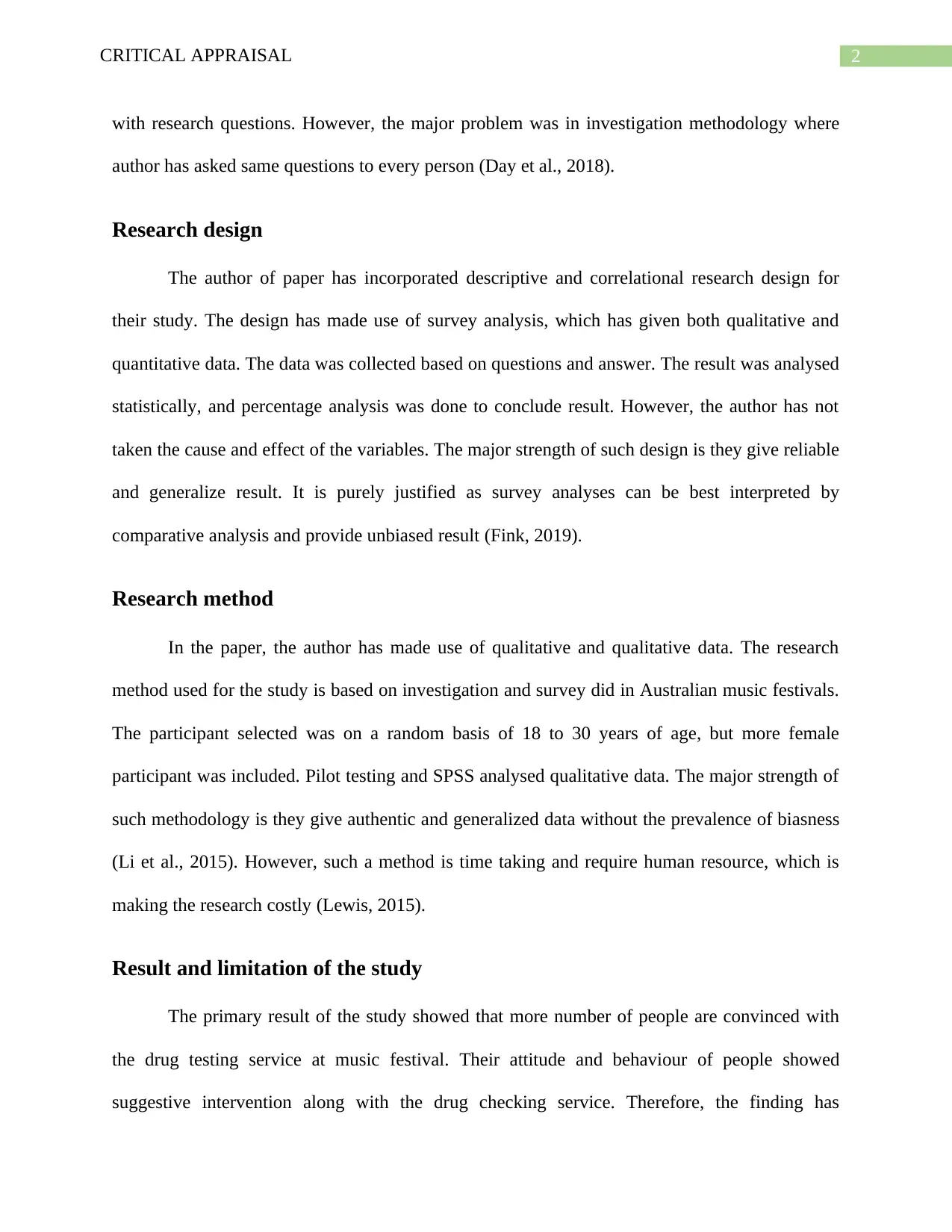
2CRITICAL APPRAISAL
with research questions. However, the major problem was in investigation methodology where
author has asked same questions to every person (Day et al., 2018).
Research design
The author of paper has incorporated descriptive and correlational research design for
their study. The design has made use of survey analysis, which has given both qualitative and
quantitative data. The data was collected based on questions and answer. The result was analysed
statistically, and percentage analysis was done to conclude result. However, the author has not
taken the cause and effect of the variables. The major strength of such design is they give reliable
and generalize result. It is purely justified as survey analyses can be best interpreted by
comparative analysis and provide unbiased result (Fink, 2019).
Research method
In the paper, the author has made use of qualitative and qualitative data. The research
method used for the study is based on investigation and survey did in Australian music festivals.
The participant selected was on a random basis of 18 to 30 years of age, but more female
participant was included. Pilot testing and SPSS analysed qualitative data. The major strength of
such methodology is they give authentic and generalized data without the prevalence of biasness
(Li et al., 2015). However, such a method is time taking and require human resource, which is
making the research costly (Lewis, 2015).
Result and limitation of the study
The primary result of the study showed that more number of people are convinced with
the drug testing service at music festival. Their attitude and behaviour of people showed
suggestive intervention along with the drug checking service. Therefore, the finding has
with research questions. However, the major problem was in investigation methodology where
author has asked same questions to every person (Day et al., 2018).
Research design
The author of paper has incorporated descriptive and correlational research design for
their study. The design has made use of survey analysis, which has given both qualitative and
quantitative data. The data was collected based on questions and answer. The result was analysed
statistically, and percentage analysis was done to conclude result. However, the author has not
taken the cause and effect of the variables. The major strength of such design is they give reliable
and generalize result. It is purely justified as survey analyses can be best interpreted by
comparative analysis and provide unbiased result (Fink, 2019).
Research method
In the paper, the author has made use of qualitative and qualitative data. The research
method used for the study is based on investigation and survey did in Australian music festivals.
The participant selected was on a random basis of 18 to 30 years of age, but more female
participant was included. Pilot testing and SPSS analysed qualitative data. The major strength of
such methodology is they give authentic and generalized data without the prevalence of biasness
(Li et al., 2015). However, such a method is time taking and require human resource, which is
making the research costly (Lewis, 2015).
Result and limitation of the study
The primary result of the study showed that more number of people are convinced with
the drug testing service at music festival. Their attitude and behaviour of people showed
suggestive intervention along with the drug checking service. Therefore, the finding has
⊘ This is a preview!⊘
Do you want full access?
Subscribe today to unlock all pages.

Trusted by 1+ million students worldwide
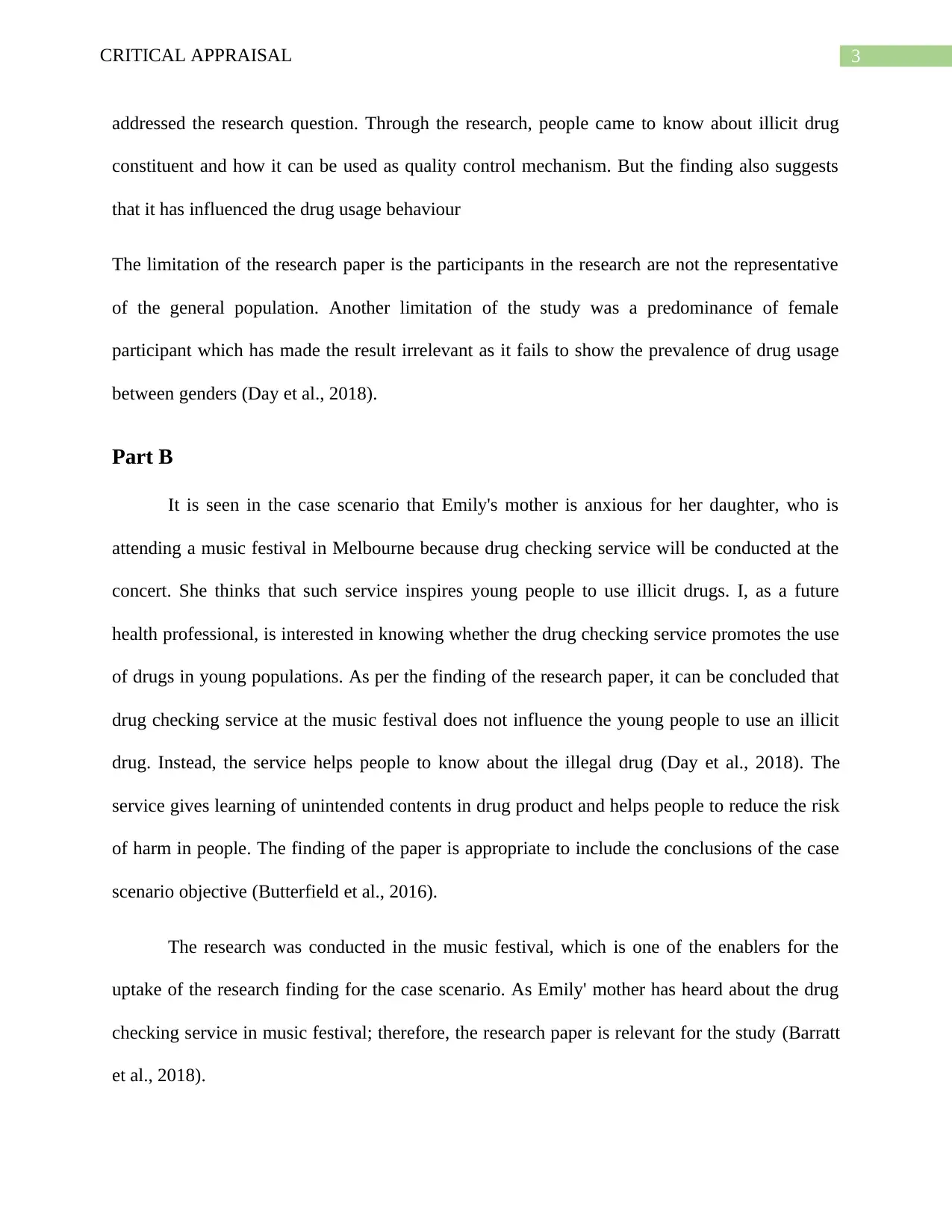
3CRITICAL APPRAISAL
addressed the research question. Through the research, people came to know about illicit drug
constituent and how it can be used as quality control mechanism. But the finding also suggests
that it has influenced the drug usage behaviour
The limitation of the research paper is the participants in the research are not the representative
of the general population. Another limitation of the study was a predominance of female
participant which has made the result irrelevant as it fails to show the prevalence of drug usage
between genders (Day et al., 2018).
Part B
It is seen in the case scenario that Emily's mother is anxious for her daughter, who is
attending a music festival in Melbourne because drug checking service will be conducted at the
concert. She thinks that such service inspires young people to use illicit drugs. I, as a future
health professional, is interested in knowing whether the drug checking service promotes the use
of drugs in young populations. As per the finding of the research paper, it can be concluded that
drug checking service at the music festival does not influence the young people to use an illicit
drug. Instead, the service helps people to know about the illegal drug (Day et al., 2018). The
service gives learning of unintended contents in drug product and helps people to reduce the risk
of harm in people. The finding of the paper is appropriate to include the conclusions of the case
scenario objective (Butterfield et al., 2016).
The research was conducted in the music festival, which is one of the enablers for the
uptake of the research finding for the case scenario. As Emily' mother has heard about the drug
checking service in music festival; therefore, the research paper is relevant for the study (Barratt
et al., 2018).
addressed the research question. Through the research, people came to know about illicit drug
constituent and how it can be used as quality control mechanism. But the finding also suggests
that it has influenced the drug usage behaviour
The limitation of the research paper is the participants in the research are not the representative
of the general population. Another limitation of the study was a predominance of female
participant which has made the result irrelevant as it fails to show the prevalence of drug usage
between genders (Day et al., 2018).
Part B
It is seen in the case scenario that Emily's mother is anxious for her daughter, who is
attending a music festival in Melbourne because drug checking service will be conducted at the
concert. She thinks that such service inspires young people to use illicit drugs. I, as a future
health professional, is interested in knowing whether the drug checking service promotes the use
of drugs in young populations. As per the finding of the research paper, it can be concluded that
drug checking service at the music festival does not influence the young people to use an illicit
drug. Instead, the service helps people to know about the illegal drug (Day et al., 2018). The
service gives learning of unintended contents in drug product and helps people to reduce the risk
of harm in people. The finding of the paper is appropriate to include the conclusions of the case
scenario objective (Butterfield et al., 2016).
The research was conducted in the music festival, which is one of the enablers for the
uptake of the research finding for the case scenario. As Emily' mother has heard about the drug
checking service in music festival; therefore, the research paper is relevant for the study (Barratt
et al., 2018).
Paraphrase This Document
Need a fresh take? Get an instant paraphrase of this document with our AI Paraphraser
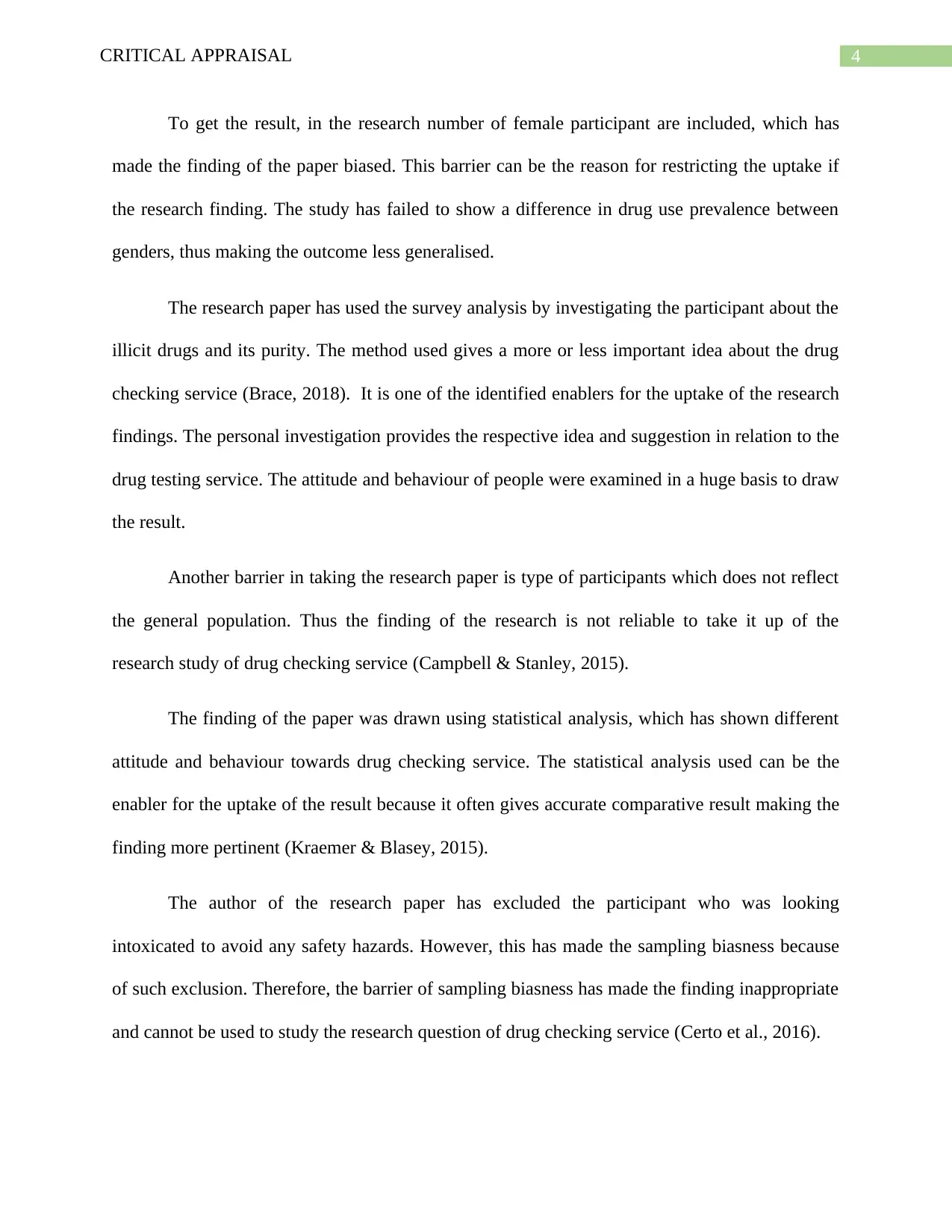
4CRITICAL APPRAISAL
To get the result, in the research number of female participant are included, which has
made the finding of the paper biased. This barrier can be the reason for restricting the uptake if
the research finding. The study has failed to show a difference in drug use prevalence between
genders, thus making the outcome less generalised.
The research paper has used the survey analysis by investigating the participant about the
illicit drugs and its purity. The method used gives a more or less important idea about the drug
checking service (Brace, 2018). It is one of the identified enablers for the uptake of the research
findings. The personal investigation provides the respective idea and suggestion in relation to the
drug testing service. The attitude and behaviour of people were examined in a huge basis to draw
the result.
Another barrier in taking the research paper is type of participants which does not reflect
the general population. Thus the finding of the research is not reliable to take it up of the
research study of drug checking service (Campbell & Stanley, 2015).
The finding of the paper was drawn using statistical analysis, which has shown different
attitude and behaviour towards drug checking service. The statistical analysis used can be the
enabler for the uptake of the result because it often gives accurate comparative result making the
finding more pertinent (Kraemer & Blasey, 2015).
The author of the research paper has excluded the participant who was looking
intoxicated to avoid any safety hazards. However, this has made the sampling biasness because
of such exclusion. Therefore, the barrier of sampling biasness has made the finding inappropriate
and cannot be used to study the research question of drug checking service (Certo et al., 2016).
To get the result, in the research number of female participant are included, which has
made the finding of the paper biased. This barrier can be the reason for restricting the uptake if
the research finding. The study has failed to show a difference in drug use prevalence between
genders, thus making the outcome less generalised.
The research paper has used the survey analysis by investigating the participant about the
illicit drugs and its purity. The method used gives a more or less important idea about the drug
checking service (Brace, 2018). It is one of the identified enablers for the uptake of the research
findings. The personal investigation provides the respective idea and suggestion in relation to the
drug testing service. The attitude and behaviour of people were examined in a huge basis to draw
the result.
Another barrier in taking the research paper is type of participants which does not reflect
the general population. Thus the finding of the research is not reliable to take it up of the
research study of drug checking service (Campbell & Stanley, 2015).
The finding of the paper was drawn using statistical analysis, which has shown different
attitude and behaviour towards drug checking service. The statistical analysis used can be the
enabler for the uptake of the result because it often gives accurate comparative result making the
finding more pertinent (Kraemer & Blasey, 2015).
The author of the research paper has excluded the participant who was looking
intoxicated to avoid any safety hazards. However, this has made the sampling biasness because
of such exclusion. Therefore, the barrier of sampling biasness has made the finding inappropriate
and cannot be used to study the research question of drug checking service (Certo et al., 2016).
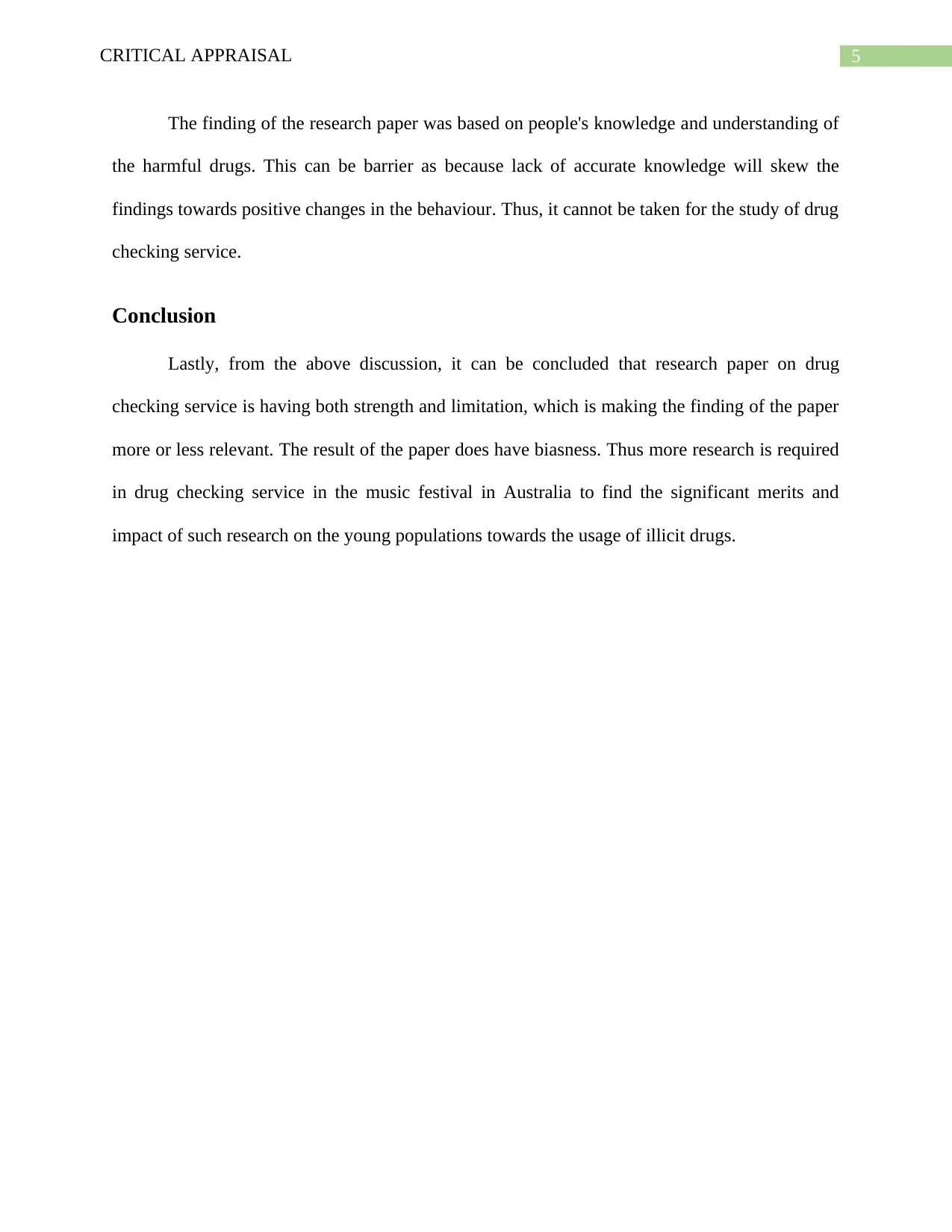
5CRITICAL APPRAISAL
The finding of the research paper was based on people's knowledge and understanding of
the harmful drugs. This can be barrier as because lack of accurate knowledge will skew the
findings towards positive changes in the behaviour. Thus, it cannot be taken for the study of drug
checking service.
Conclusion
Lastly, from the above discussion, it can be concluded that research paper on drug
checking service is having both strength and limitation, which is making the finding of the paper
more or less relevant. The result of the paper does have biasness. Thus more research is required
in drug checking service in the music festival in Australia to find the significant merits and
impact of such research on the young populations towards the usage of illicit drugs.
The finding of the research paper was based on people's knowledge and understanding of
the harmful drugs. This can be barrier as because lack of accurate knowledge will skew the
findings towards positive changes in the behaviour. Thus, it cannot be taken for the study of drug
checking service.
Conclusion
Lastly, from the above discussion, it can be concluded that research paper on drug
checking service is having both strength and limitation, which is making the finding of the paper
more or less relevant. The result of the paper does have biasness. Thus more research is required
in drug checking service in the music festival in Australia to find the significant merits and
impact of such research on the young populations towards the usage of illicit drugs.
⊘ This is a preview!⊘
Do you want full access?
Subscribe today to unlock all pages.

Trusted by 1+ million students worldwide
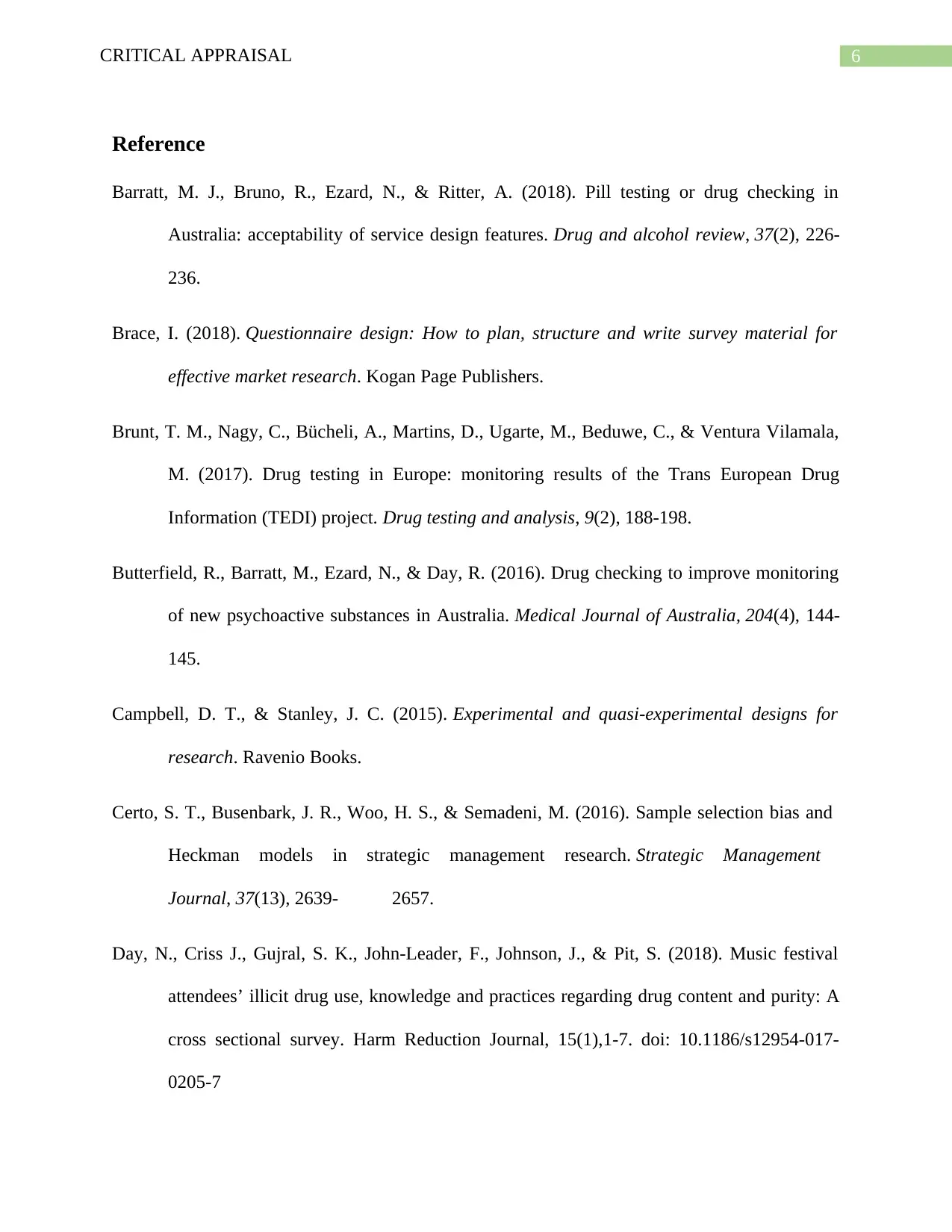
6CRITICAL APPRAISAL
Reference
Barratt, M. J., Bruno, R., Ezard, N., & Ritter, A. (2018). Pill testing or drug checking in
Australia: acceptability of service design features. Drug and alcohol review, 37(2), 226-
236.
Brace, I. (2018). Questionnaire design: How to plan, structure and write survey material for
effective market research. Kogan Page Publishers.
Brunt, T. M., Nagy, C., Bücheli, A., Martins, D., Ugarte, M., Beduwe, C., & Ventura Vilamala,
M. (2017). Drug testing in Europe: monitoring results of the Trans European Drug
Information (TEDI) project. Drug testing and analysis, 9(2), 188-198.
Butterfield, R., Barratt, M., Ezard, N., & Day, R. (2016). Drug checking to improve monitoring
of new psychoactive substances in Australia. Medical Journal of Australia, 204(4), 144-
145.
Campbell, D. T., & Stanley, J. C. (2015). Experimental and quasi-experimental designs for
research. Ravenio Books.
Certo, S. T., Busenbark, J. R., Woo, H. S., & Semadeni, M. (2016). Sample selection bias and
Heckman models in strategic management research. Strategic Management
Journal, 37(13), 2639- 2657.
Day, N., Criss J., Gujral, S. K., John-Leader, F., Johnson, J., & Pit, S. (2018). Music festival
attendees’ illicit drug use, knowledge and practices regarding drug content and purity: A
cross sectional survey. Harm Reduction Journal, 15(1),1-7. doi: 10.1186/s12954-017-
0205-7
Reference
Barratt, M. J., Bruno, R., Ezard, N., & Ritter, A. (2018). Pill testing or drug checking in
Australia: acceptability of service design features. Drug and alcohol review, 37(2), 226-
236.
Brace, I. (2018). Questionnaire design: How to plan, structure and write survey material for
effective market research. Kogan Page Publishers.
Brunt, T. M., Nagy, C., Bücheli, A., Martins, D., Ugarte, M., Beduwe, C., & Ventura Vilamala,
M. (2017). Drug testing in Europe: monitoring results of the Trans European Drug
Information (TEDI) project. Drug testing and analysis, 9(2), 188-198.
Butterfield, R., Barratt, M., Ezard, N., & Day, R. (2016). Drug checking to improve monitoring
of new psychoactive substances in Australia. Medical Journal of Australia, 204(4), 144-
145.
Campbell, D. T., & Stanley, J. C. (2015). Experimental and quasi-experimental designs for
research. Ravenio Books.
Certo, S. T., Busenbark, J. R., Woo, H. S., & Semadeni, M. (2016). Sample selection bias and
Heckman models in strategic management research. Strategic Management
Journal, 37(13), 2639- 2657.
Day, N., Criss J., Gujral, S. K., John-Leader, F., Johnson, J., & Pit, S. (2018). Music festival
attendees’ illicit drug use, knowledge and practices regarding drug content and purity: A
cross sectional survey. Harm Reduction Journal, 15(1),1-7. doi: 10.1186/s12954-017-
0205-7
Paraphrase This Document
Need a fresh take? Get an instant paraphrase of this document with our AI Paraphraser
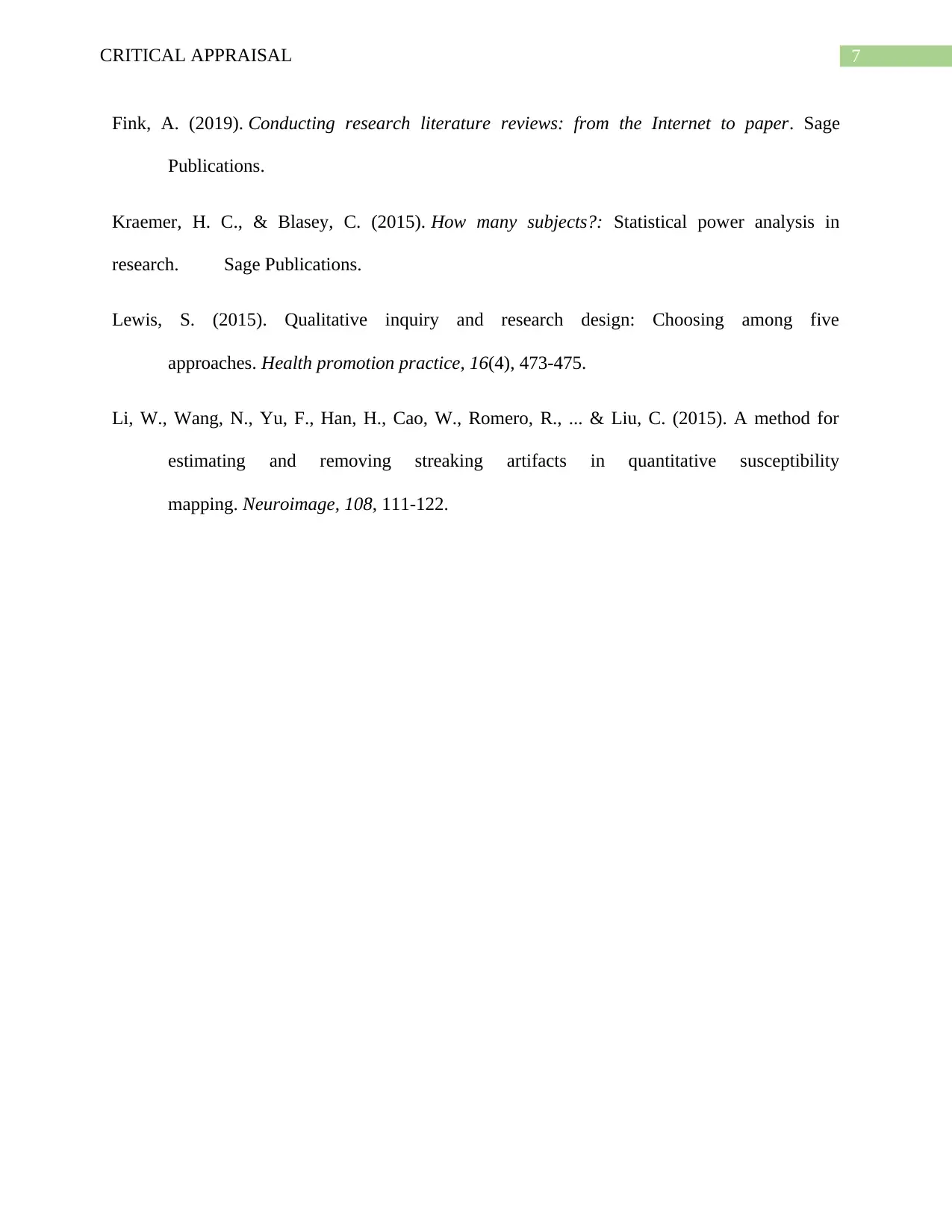
7CRITICAL APPRAISAL
Fink, A. (2019). Conducting research literature reviews: from the Internet to paper. Sage
Publications.
Kraemer, H. C., & Blasey, C. (2015). How many subjects?: Statistical power analysis in
research. Sage Publications.
Lewis, S. (2015). Qualitative inquiry and research design: Choosing among five
approaches. Health promotion practice, 16(4), 473-475.
Li, W., Wang, N., Yu, F., Han, H., Cao, W., Romero, R., ... & Liu, C. (2015). A method for
estimating and removing streaking artifacts in quantitative susceptibility
mapping. Neuroimage, 108, 111-122.
Fink, A. (2019). Conducting research literature reviews: from the Internet to paper. Sage
Publications.
Kraemer, H. C., & Blasey, C. (2015). How many subjects?: Statistical power analysis in
research. Sage Publications.
Lewis, S. (2015). Qualitative inquiry and research design: Choosing among five
approaches. Health promotion practice, 16(4), 473-475.
Li, W., Wang, N., Yu, F., Han, H., Cao, W., Romero, R., ... & Liu, C. (2015). A method for
estimating and removing streaking artifacts in quantitative susceptibility
mapping. Neuroimage, 108, 111-122.
1 out of 8
Related Documents
Your All-in-One AI-Powered Toolkit for Academic Success.
+13062052269
info@desklib.com
Available 24*7 on WhatsApp / Email
![[object Object]](/_next/static/media/star-bottom.7253800d.svg)
Unlock your academic potential
Copyright © 2020–2025 A2Z Services. All Rights Reserved. Developed and managed by ZUCOL.




